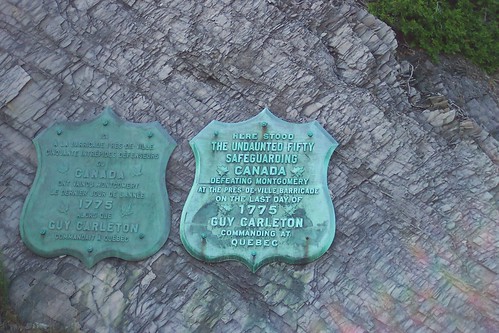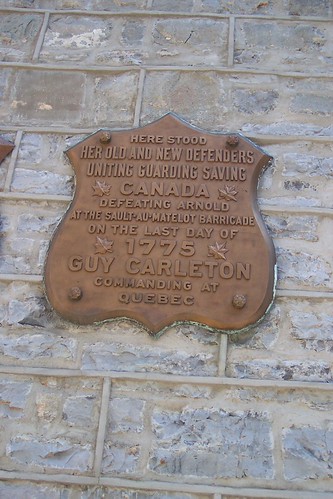The Battle of Quebec: December 31, 1775
This was originally posted on this site on December 31, 2010.

Plaque erected in Quebec City marking the spot of American General Richard Montgomery’s death. “Here stood the Undaunted Fifty safeguarding Canada, defeating Montgomery at the Pres de Ville Barricade on the last day of 1775, Guy Carleton commanding at Quebec.”
Two hundred and thirty-five years ago tonight, American soldiers attacked the city of Quebec during a raging blizzard in a desperate attempt to capture Canada early in the Revolutionary War. Two separate American expeditions converged in the vicinity of Quebec City in December 1775. One led by General Richard Montgomery had moved up Lake Champlain from Albany, captured Montreal, and came to Quebec from the southwest. The other force, commanded by Benedict Arnold, had originated in Cambridge from the colonial forces gathered around Boston in the aftermath of Lexington and Concord and the Battle of Bunker Hill. George Washington had ordered Arnold to lead a force through the wilderness of Maine and approach Quebec from the southeast. Inland portions of Maine were so wild and unexplored, however, that both Washington nor Arnold grossly underestimated the distances involved. By the time they reached Canada, more than half of Arnold’s force had either died or turned back.
Because Canada had only become a British possession sixteen years earlier, the Americans hoped to recruit many French Canadian residents to their cause, but most either ignored the Americans or sided with the handful of British defenders of the city. Without a popular uprising and lacking artillery sufficient to overcome the walls of the city, Montgomery and Arnold decided that their only chance of success was to attack during a snowstorm. The opportunity arose on New Year’s Eve. Montgomery led his force from the west along the banks of the Saint Lawrence. Arnold would come in from the northeast, skirting the walls of the upper city. The Americans hoped to first capture the lower city and then move upward to the main portion of Quebec.
Montgomery’s force met with some initial success, but the snow obscured a heavily defended British-Canadian blockhouse. As Montgomery and his aides passed nearby, those inside fired a cannon which wiped out the American command group, causing the rest of the force to immediately retreat. Arnold fared little better. He made it into the lower city, but the narrow streets of the old town restricted his ability to maneuver. Arnold was shot in the foot and was evacuated by his men. Those who stayed behind were soon surrounded and surrendered.
In the aftermath of the battle, Arnold and the surviving Americans loitered around Quebec for some time, but the knowledge that no American reinforcements were en route and the certainty that a large British force would arrive from Europe as soon as the St Lawrence melted led Arnold to withdraw to the colonies. No further attempt to capture Canada was made by the Americans. Ironically, the 8,000-man British Army that arrived that spring was the same one that advanced down Lake Champlain in 1777 and ultimately surrendered to the Americans in the Saratoga campaign.
Below shows the plaque where the American force led by Benedict Arnold was stopped by the British and Canadian defenders. Here stood her old and new defenders uniting, guarding, saving Canada, defeating Arnold at the Sault-au-Matelot barricade on the last day of 1775, Guy Carleton commanding at Quebec

Always interesting to recall this battle. Thanks for posting.